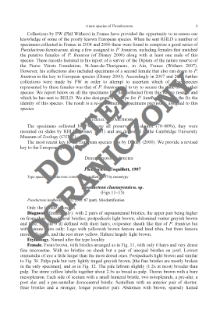
Obiekt
Tytuł: Successional changes and diversity of mesostigmatid mite communities (Acari: Mesostigmata) on reclaimed power plant waste dumps
Inny tytuł:
Annales Zoologici, vol. 58, no 2
Współtwórca:
Muzeum i Instytut Zoologii Polskiej Akademii Nauk
Wydawca:
Miejsce wydania:
Opis:
Bibliogr. p. 277-278 ; P. 267-278 : ill. ; 27 cm ; Taxa in Latin
Typ obiektu:
Abstrakt:
Secondary succession of mesostigmatid soil mites was studied in two types of reclaimed electric power plant waste dumps in Łaziska Górne (Upper Silesia, Poland) in1997–1998. The dumps on which the studies were carried out differed in their construction and structure. We sampled 6 sites from 2 localities (Sites I–III and IV–VI), representing 3stages of ecological succession. The sites differed floristically and in substrate physiochemistry i.e. organic carbon content (Corg) and total nitrogen (Nt). Site I representing pioneerstage was characterized by a poorly developed herb layer, a lack of trees and shrubs, andlow Corg, Nt and humus content. Sites III, V and VI represented a pre-forest stage and were characterized by a larger number of plant species, higher percent cover of trees and shrubs, and high Corg, Nt and humus content. Sites II and IV represented an intermediate stages of succession. In 18 months, we took 540 samples of soil and litter, and we collected 4811 mites, assigned to 86 species of mesostigmatid mites. The mite communities differedbetween successional stages, mostly with respect to the relative dominance among species. At the pioneer stage of succession, the mite community was characterized by a “degraded” model of species abundance distribution, with a high dominance of Asca bicornis. At more advanced ecological stages (Sites III, V and VI), mite communities had similarities withcommunities of forest. Some of the most abundant species in Sites III, V and VI were typical forest inhabitants. Sites I–III represent a real succession of plant communities, soil development and mite communities, showing an increase in species richness of mites, diversity indices and of the number of dominant species (creative type of succession). The succession within Sites IV–VI reveals a different course (rise-and-fall).
Czasopismo/Seria/cykl:
Tom:
Zeszyt:
Strona pocz.:
Strona końc.:
Szczegółowy typ zasobu:
Format:
Identyfikator zasobu:
Źródło:
MiIZ PAN, call no. P.255, vol 58, no 2 ; MiIZ PAN, call no. P.4314, vol 58, no 2 ; kliknij tutaj, żeby przejść
Język:
Język streszczenia:
Prawa:
Rights Reserved - Restricted Access
Zasady wykorzystania:
Digitalizacja:
Museum and Institute of Zoology of the Polish Academy of Sciences
Lokalizacja oryginału:
Library of the Museum and Institute of Zoology of the Polish Academy of Sciences
Dofinansowane ze środków:
Programme Innovative Economy, 2010-2014, Priority Axis 2. R&D infrastructure ; European Union. European Regional Development Fund
Dostęp:
Kolekcje, do których przypisany jest obiekt:
- Repozytorium Cyfrowe Instytutów Naukowych > Kolekcje Partnerów > Muzeum i Instytut Zoologii PAN > Czasopisma
- Repozytorium Cyfrowe Instytutów Naukowych > Kolekcje Partnerów > Muzeum i Instytut Zoologii PAN > Wydawnictwa MiIZ PAN > Annales Zoologici
- Repozytorium Cyfrowe Instytutów Naukowych > Piśmiennictwo > Czasopisma/Artykuły
Data ostatniej modyfikacji:
2 paź 2020
Data dodania obiektu:
6 maj 2016
Liczba pobrań / odtworzeń:
58
Wszystkie dostępne wersje tego obiektu:
https://rcin.org.pl./publication/55684
Wyświetl opis w formacie RDF:
Wyświetl opis w formacie RDFa:
Wyświetl opis w formacie OAI-PMH:
Obiekty Podobne
Pysarenko, Svitlana
Blaszakiella americana gen. et sp. nov. : a new zerconid mite (Acari: Zerconidae) from North America
Sikora, Bożena Skoracki, Maciej
Skubała, Piotr Dziuba, Stanisław Polska Akademia Nauk. Muzeum i Instytut Zoologii
Błoszyk, Jerzy Halliday, Robert Bruce (1950– ) Polska Akademia Nauk. Muzeum i Instytut Zoologii
Dziuba, Stanisław (1927–2007)
Gwiazdowicz, Dariusz J. (1966– ) Łakomy, Piotr (1966– ) Polska Akademia Nauk. Muzeum i Instytut Zoologii
Skorupski, Maciej Gwiazdowicz, Dariusz J. (1966– ) Polska Akademia Nauk. Muzeum i Instytut Zoologii
Wiśniewski, Jerzy (1935– )

 INSTYTUT ARCHEOLOGII I ETNOLOGII POLSKIEJ AKADEMII NAUK
INSTYTUT ARCHEOLOGII I ETNOLOGII POLSKIEJ AKADEMII NAUK
 INSTYTUT BADAŃ LITERACKICH POLSKIEJ AKADEMII NAUK
INSTYTUT BADAŃ LITERACKICH POLSKIEJ AKADEMII NAUK
 INSTYTUT BADAWCZY LEŚNICTWA
INSTYTUT BADAWCZY LEŚNICTWA
 INSTYTUT BIOLOGII DOŚWIADCZALNEJ IM. MARCELEGO NENCKIEGO POLSKIEJ AKADEMII NAUK
INSTYTUT BIOLOGII DOŚWIADCZALNEJ IM. MARCELEGO NENCKIEGO POLSKIEJ AKADEMII NAUK
 INSTYTUT BIOLOGII SSAKÓW POLSKIEJ AKADEMII NAUK
INSTYTUT BIOLOGII SSAKÓW POLSKIEJ AKADEMII NAUK
 INSTYTUT CHEMII FIZYCZNEJ PAN
INSTYTUT CHEMII FIZYCZNEJ PAN
 INSTYTUT CHEMII ORGANICZNEJ PAN
INSTYTUT CHEMII ORGANICZNEJ PAN
 INSTYTUT FILOZOFII I SOCJOLOGII PAN
INSTYTUT FILOZOFII I SOCJOLOGII PAN
 INSTYTUT GEOGRAFII I PRZESTRZENNEGO ZAGOSPODAROWANIA PAN
INSTYTUT GEOGRAFII I PRZESTRZENNEGO ZAGOSPODAROWANIA PAN
 INSTYTUT HISTORII im. TADEUSZA MANTEUFFLA POLSKIEJ AKADEMII NAUK
INSTYTUT HISTORII im. TADEUSZA MANTEUFFLA POLSKIEJ AKADEMII NAUK
 INSTYTUT JĘZYKA POLSKIEGO POLSKIEJ AKADEMII NAUK
INSTYTUT JĘZYKA POLSKIEGO POLSKIEJ AKADEMII NAUK
 INSTYTUT MATEMATYCZNY PAN
INSTYTUT MATEMATYCZNY PAN
 INSTYTUT MEDYCYNY DOŚWIADCZALNEJ I KLINICZNEJ IM.MIROSŁAWA MOSSAKOWSKIEGO POLSKIEJ AKADEMII NAUK
INSTYTUT MEDYCYNY DOŚWIADCZALNEJ I KLINICZNEJ IM.MIROSŁAWA MOSSAKOWSKIEGO POLSKIEJ AKADEMII NAUK
 INSTYTUT PODSTAWOWYCH PROBLEMÓW TECHNIKI PAN
INSTYTUT PODSTAWOWYCH PROBLEMÓW TECHNIKI PAN
 INSTYTUT SLAWISTYKI PAN
INSTYTUT SLAWISTYKI PAN
 SIEĆ BADAWCZA ŁUKASIEWICZ - INSTYTUT TECHNOLOGII MATERIAŁÓW ELEKTRONICZNYCH
SIEĆ BADAWCZA ŁUKASIEWICZ - INSTYTUT TECHNOLOGII MATERIAŁÓW ELEKTRONICZNYCH
 MUZEUM I INSTYTUT ZOOLOGII POLSKIEJ AKADEMII NAUK
MUZEUM I INSTYTUT ZOOLOGII POLSKIEJ AKADEMII NAUK
 INSTYTUT BADAŃ SYSTEMOWYCH PAN
INSTYTUT BADAŃ SYSTEMOWYCH PAN
 INSTYTUT BOTANIKI IM. WŁADYSŁAWA SZAFERA POLSKIEJ AKADEMII NAUK
INSTYTUT BOTANIKI IM. WŁADYSŁAWA SZAFERA POLSKIEJ AKADEMII NAUK


































